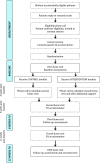'On Your Feet to Earn Your Seat', a habit-based intervention to reduce sedentary behaviour in older adults: study protocol for a randomized controlled trial
- PMID: 25240737
- PMCID: PMC4180306
- DOI: 10.1186/1745-6215-15-368
'On Your Feet to Earn Your Seat', a habit-based intervention to reduce sedentary behaviour in older adults: study protocol for a randomized controlled trial
Abstract
Background: Many older adults are both highly sedentary (that is, spend considerable amounts of time sitting) and physically inactive (that is, do little physical activity). This protocol describes an exploratory trial of a theory-based behaviour change intervention in the form of a booklet outlining simple activities ('tips') designed both to reduce sedentary behaviour and to increase physical activity in older adults. The intervention is based on the 'habit formation' model, which proposes that consistent repetition leads to behaviour becoming automatic, sustaining activity gains over time.
Methods: The intervention is being developed iteratively, in line with Medical Research Council complex intervention guidelines. Selection of activity tips was informed by semi-structured interviews and focus groups with older adults, and input from a multidisciplinary expert panel. An ongoing preliminary field test of acceptability among 25 older adults will inform further refinement. An exploratory randomized controlled trial will be conducted within a primary care setting, comparing the tips booklet with a control fact sheet. Retired, inactive and sedentary adults (n = 120) aged 60 to 74 years, with no physical impairments precluding light physical activity, will be recruited from general practices in north London, UK. The primary outcomes are recruitment and attrition rates. Secondary outcomes are changes in behaviour, habit, health and wellbeing over 12 weeks.
Discussion: Data will be used to inform study procedures for a future, larger-scale definitive randomized controlled trial.
Trial registration: Current Controlled Trials ISRCTN47901994.
References
Publication types
MeSH terms
Associated data
Grants and funding
LinkOut - more resources
Full Text Sources
Other Literature Sources
Medical


